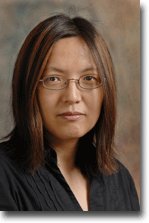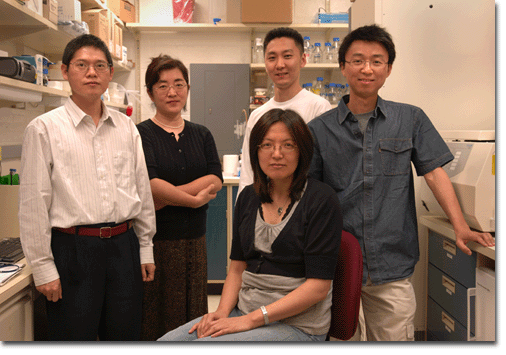 |
Yie Liu, Ph.D., Investigator Unit on Telomere Length Regulation and Maintenance Laboratory of Molecular Gerontology Phone: 410-558-8419 Fax: 410-558-8157 E-mail: liuyie@grc.nia.nih.gov |
| Biography: Dr. Yie Liu received her Ph.D. at Karolinska Institute, Sweden in 1995. Dr. Liu joined the University of Toronto as a postdoctoral fellow of the National Cancer Institute of Canada until 2001, and then became a Senior Research Scientist at Oak Ridge National Laboratory in 2002. Dr. Liu started at NIA in 2006. |
| Repair and Maintenance of Eroded Telomeres in Mammals Most eukaryotic chromosome ends terminate in structures of repetitive DNA sequences and associated proteins, called telomeres. Telomeres allow cells to distinguish natural chromosome ends from damaged DNA and to protect chromosomes against degradation and fusion. Telomere integrity in cells thus plays an essential role in controlling genomic stability. Loss of genetic material at chromosome ends ("telomere shortening") is frequently observed in elder populations, cellular senescence, and premature aging syndromes. Furthermore, telomere dysfunction contributes to genomic instability that leads to cell death, cell proliferation defects, and malignant transformation, which might in turn contribute to age related-disorders and a higher incidence of cancer during aging. |
| Accumulating evidence suggests that telomere integrity depends on the ability to maintain telomere length and/or the ability to mask telomeres from being recognized as damaged DNA. In mammals, telomeres normally exist in a loop structure with 3' single stranded telomeric DNA overhang concealed within the telomere double helix. This t-loop configuration is believed to protect chromosome ends from being recognized as broken DNA. Disruption of the telomere loop and subsequent exposure of the 3' overhang represents the uncapped state of telomeres. Telomerase and telomere associated proteins play essential roles in telomere length maintenance and telomere capping functions. Telomerase replenishes telomere loss due to incomplete DNA replication in almost all eukaryotes. Loss of telomerase activity leads to attrition of telomeric DNA, which, in turn, is known to trigger chromosome end-to-end fusions, genomic instability, and cell arrest or death. Recent studies have shown that uncapped telomeres directly associate with many DNA damage response proteins in telomere-initiated cellular senescence, indicating that DNA damage repair proteins interact with telomere as a DNA damage check-point response during cellular senescence. Several DNA damage repair proteins are also critical in protecting telomere and chromosome integrity. |
| Dr. Liu's research focuses on developing new mouse models or using existing mouse models to study the genes or pathways that are important in telomere length regulation and maintenance and genomic stability. Previously while working at the Ontario Cancer Institute, Canada, Dr. Liu has established the mouse and mouse embryonic stem (ES) cells deficient in telomerase reverse transcript, TERT, the catalytic protein component of telomerase. Disruption of the mouse telomerase provided genetic evidence in mammals that telomerase-dependent telomere maintenance is critical for long-term cell survival and genome integrity and limiting telomerase activity preferentially maintain critically shortened telomeres and genome stability. The TERT deficient animals and ES cells provide excellent genetic tools in studying cellular response to telomere dysfunction. Using a combination of molecular, genetic and biochemical analyses, Dr. Liu's lab will continue to study the genes or pathways that contribute to genomic instability and cell apoptosis triggered by telomere erosion in telomerase deficient mice or ES cells. In addition, Dr. Liu's lab use existing DNA damage repair deficient mice to study the mechanisms of DNA damage repair proteins, especially base excision repair and mismatch repair proteins in protecting telomere integrity. Dr. Liu's laboratory has illustrated that PARP1 and MSH2 play a role in maintaining telomere capping function. Liu's laboratory will continue to investigate the mechanisms of these proteins in telomere regulation and maintenance in vivo. The fact that telomere length regulation and maintenance and telomerase complex is evolutionarily conserved may allow us to extend these findings to humans. |
|
 |
| Unit on Telomere Length Regulation and Maintenance (left to right). Row 1: Yie Liu; row 2: Zhilong Wang, Fang Zhou, David Rhee, Jian Lu. |
| IRP Home What's New Contact Us Accessibility Disclaimer Privacy Site Search Site Map NIA Home |
 |
 |
 |